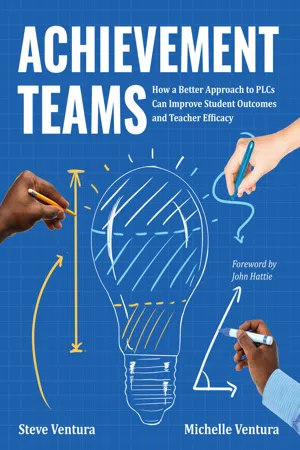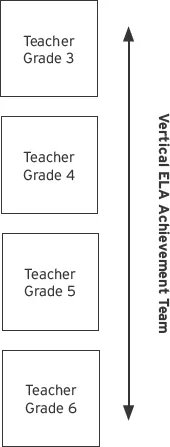![]()
Chapter 1
Setting Up the Achievement Team
. . . . . . . . . . . . . . . . . . . .
Isolation is the enemy of learning.
—National Association of Elementary School Principals
In recent years, teacher collaboration has deepened and now has a much broader influence on educational outcomes. Many schools and districts now focus on improving and expanding teacher impact, encouraging teachers to share their strategies as they accelerate student achievement. Achievement Teams do just that.
With Achievement Teams, members are responsible for a number of tasks. The most important among them are evaluating their instructional impact and identifying gaps in learning. Once a team has identified those gaps, members can begin to address them.
How Do We Create Teams?
Forming Achievement Teams is a joint responsibility of building leadership and team participants, although teams often form organically. The size of the teams and the number of teams at a single site are based on school size, faculty size, and other factors. An ideal team size would be three to six teachers, with at least two and generally no more than seven members to a team.
Based on our personal observation, there are three common models of team formation:
- Horizontal teams
- Vertical teams
- Specialist and elective teams
Horizontal Teams
Forming horizontal teams is probably the most common approach to bringing teachers together because these teams typically consist of teachers from the same grade level and content area (see Figure 1.1). Horizontal teams develop and administer common formative assessments and share the same goals and purpose. For example, after reviewing assessment results and other grade-level indicators, horizontal teams may consider revising their focus based on the evidence they have collected. This focus can target a subject area, an identified student population, or even micro-trend data, like data related to question rigor (easy, medium, or hard).
Figure 1.1. Horizontal Algebra I Achievement Team
Vertical Teams
Vertical teams (see Figure 1.2) can be just as effective as horizontal teams. In our experience, having worked in the roles of teacher, principal, and district superintendent, some schools simply do not have enough grade-level teachers to form a horizontal team. However, this need not be a cause for alarm, because many opportunities and configurations support vertical teaming.
Figure 1.2. Vertical ELA Achievement Team
For example, small or rural schools use vertically aligned teams to maximize collaboration while creating learning opportunities or grade-level progressions. Members of a vertical team may not be able to administer a common formative assessment, but they can use formative assessments specific to their content area.
Vertical teams can focus on vertically aligned content areas, like math and English language arts (ELA). Many curriculum guides are written in a manner that makes this possible. For example, a vertical ELA team might consist of one 4th grade teacher, one 5th grade teacher, and one 6th grade teacher. Even though team members cannot administer the same assessment, they can assess vertical skills, such as students' ability to compare and contrast, analyze text, and determine the central idea in a text. Such an assessment can provide tremendous insight into how students perform as they matriculate from one grade level to the next.
Vertical team members can
- Share their individual assessment results.
- Share how they teach a lesson.
- Share student work samples.
Schools can design vertical teams in other ways. Some schools may have leadership teams made up of a teacher representative from each horizontal or vertical Achievement Team. In this situation, the teacher representatives meet to discuss common goals, strengths, and weaknesses trending across grade-level and curricular areas. This vertical team can develop a schoolwide focus on strengthening effective teaching strategies, creating a shared vocabulary, and providing support structures for students to successfully move from one grade level to the next. Even more compelling are vertical teams' opportunities to cross-reference horizontal work and continue to recognize and close gaps in schoolwide learning. For example, a P.E. teacher in a vertical team who is focusing on nonfiction writing may cross-reference scoring guides and success criteria from grade-level horizontal teams and use them to instill commonalities. This supports all educators working toward a schoolwide goal and gives them a common language and focus.
Specialist and Elective Teams
These teams consist of teachers who may have a single prep or content area. Following are some examples of areas that specialist teams may pull from:
- Foreign language
- Choir
- Physical education
- Music and band
- Art
- Coding and technology
- Health
- Life skills
- Religion
- Auto mechanics
- Business accounting
Specialist teams represent the most diverse teaming. However, a common thread runs through them. Many of these team members will have taught the same students; they also have multiple opportunities to collaborate around common targets. Elective teachers who collaborate typically base that collaboration on target areas stressed by core teaching classrooms.
For example, in many of our clients' schools, elective teachers agree that writing is essential in specialist disciplines. Beyond promoting strong literacy, writing as an instructional strategy has led to increased levels of student success in just about all areas of the curriculum. If a specialist team were to address this topic, teachers in the various electives would ask their students to respond to different writing prompts, but they all would use the same scoring guide or rubric to assess the writing.
For example, physical education teachers might ask students to write about this volleyball prompt:
If you could add two rules to volleyball, what would they be and why? Include two to three reasons to support your thinking.
There is a common pushback from teachers about assigning writing in elective classes: "We don't teach writing." The fact is, you don't need to be a writing teacher to know if students can summarize a text or locate the main idea. And ferreting out this information can be exceptionally helpful, to both the student and the teacher.
What About Time?
Clients often ask us how long an Achievement Team meeting should last. The answer is, it depends. Schools and districts have dedicated a different number of collaboration minutes depending on their schedules. When teachers have a set time to meet, it's best not to saddle that time with a long agenda or other administrative duties. In one cycle, typically over the course of one month, Achievement Teams will meet twice; they'll meet first for the pre-assessment review and then, approximately two to three weeks later, for the post-assessment review.
The pre-assessment meeting should focus on increasing collaboration around the following four-step Achievement Teams protocol to improve teaching strategies and student achievement:
Step 1. Collect and chart the data.
Step 2. Set SMART goals.
Step 3. Create baseline evidence statements.
Step 4. Select high-yield instructional strategies.
Generally, the first two steps don't require as much time as the last two because they're preparing for the deeper discussions that occur later on. Often, teams will have already entered their assessment results into a collection form we provide (Step 1). This form uses a simple algorithm to suggest a SMART goal between the pre- and post-assessment in the specific area the teachers are targeting (Step 2). The first two steps should drive the subsequent conversation around what is and isn't working for students (Step 3) and allow plenty of time to determine which instructional strategies teachers will implement (Step 4). A good rule of thumb is the 20/80 principle: Steps 1 and 2 should take about 20 percent of the time, and Steps 3 and 4 should take about 80 percent of the time.
Figure 1.3 shows recommended timing suggestions for all four steps in meetings that last from 45 to 90 minutes. Teams should find the time allotments that work best for them depending on need.
Figure 1.3. Sample Achievement Teams Time Allotment
Total Time: 45 minutes
Steps 1 and 2, 20% of the meeting, 9 minutes
Steps 3 and 4, 80% of the meeting, 36 minutes
* * *
Total Time: 60 minutes
Steps 1 and 2, 20% of the meeting, 12 minutes
Steps 3 and 4, 80% of the meeting, 48 minutes
* * *
Total Time: 75 minutes
Steps 1 and 2, 20% of the meeting, 15 minutes
Steps 3 and 4, 80% of the meeting, 60 minutes
* * *
Total Time: 90 minutes
Steps 1 and 2, 20% of the meeting, 18 minutes
Steps 3 and 4, 80% of the meeting, 72 minutes
The post-assessment meeting is a synthesis of the whole process and provides an opportunity for educators to determine whether they attained their goals. During this session, team members assess their impact as teachers and leave with summative statements about what worked in that cycle, how many students are still struggling, and whether they need to provide additional buffer instruction. A post-assessment meeting does not require as much time as a pre-a...


